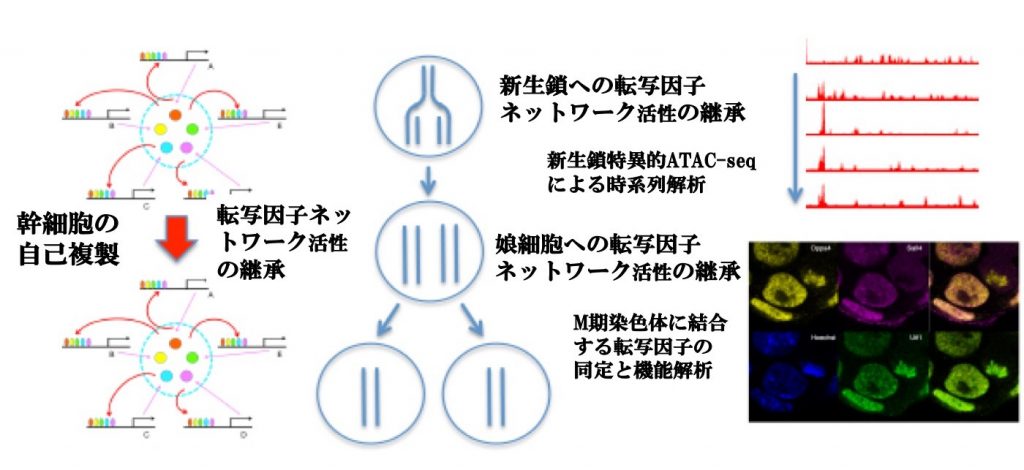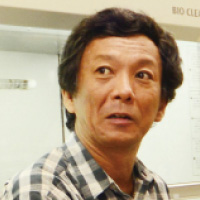クロマチン複製における転写因子ネットワークの継承機構の解析
研究内容
細胞種特異的転写因子群の発現は、それらの相互制御状態が、特定の細胞外シグナル入力下で安定に維持されることにより達成される。このような転写因子群のシグナル入力依存的な相互制御状態は、「転写因子ネットワーク」と呼ばれる。増殖能を持つ細胞においては、転写因子ネットワーク活性も、正確に複製されて娘細胞へと継承される必要がある。しかし、ゲノム複製と転写因子ネットワーク活性の維持ないしは遷移が、どのような分子機構で制御されているのかは、極めて重要な問題であるにもかかわらず、未だに明らかにはできていない。そこで、本計画研究においては、新学術領域の連携を生かし、DNA複製ならびに細胞分裂に伴い、転写因子はどのようにゲノムへの結合を回復し、転写因子ネットワーク活性を維持するのか、ないしはそれを遷移させ細胞を分化させるのか、鍵になる転写因子を同定し、その機能を明らかにすることを目的とする。申請者はこれまでに特定領域研究やCREST研究などの支援を受け、マウスES細胞における転写因子Oct3/4, Sox2, Esrrb, Klf2, Klf4, Klf5などの機能を解明してきた。さらに、これらの研究成果を踏まえ、細胞分化状態を規定するための、転写因子のシグナル入力依存的な相互制御状態を「転写因子ネットワーク」として改めて定義し、概念形成の観点からも貢献してきた。本計画研究が首尾よく達成されれば、その概念のさらなる明確化が進むとともに、細胞分化状態の操作技術開発にも貢献することが期待できる。

主な論文
- Niwa, H., et al. (4人中1番目)Self-renewal of pluripotent embryonic stem cells is mediated via activation of STAT3. Genes Dev 12, 2048-2060 (1998)(査読有。被引用回数1029)
- Niwa, H.*, et al.(3人中1番目)Quantitative expression of Oct-3/4 defines differentiation, dedifferentiation or self-renewal of ES cells. Nat Genet 24, 372-376 (2000)(査読有。被引用回数2403)
- Fujikura, F., et al. Niwa, H.* (8人中8番目)Differentiation of embryonic stem cells is induced by GATA factors. Genes Dev 16, 784-789 (2002)(査読有。被引用回数339)
- Niwa, H.*, et al.(7人中1番目)Interaction between Oct3/4 and Cdx2 determines trophectoderm differentiation. Cell 123, 917-929 (2005)(査読有。被引用回数681)
- Niwa, H.* (1人中1番目) How is pluripotency determined and maintained? Development 134, 635-646 (2007)(総説。査読有。被引用回数536)
- Masui, S.*, et al. Niwa, H.*: (12人中12番目)Pluripotency governed by Sox2 via regulation of Oct3/4 expression in mouse embryonic stem cells. Nat Cell Biol 9, 625-635 (2007) (査読有。被引用回数664)
- Niwa, H.*, et al.(4人中1番目)A parallel circuit of LIF signaling pathways maintains pluripotency of mouse ES cells. Nature 460, 118-122 (2009) (査読有。被引用回数506)
- Martello, G., et al. Niwa, H.* and Smith, A.* (9人中8番目)Esrrb is a pivotal target of the GSK3/Tcf3 axis regulating embryonic stem cell self-renewal. Cell Stem Cell 11, 491-504 (2012) (査読有。被引用回数200)
- Adachi, K., et al. Niwa, H.*(9人中9番目)Context-dependent wiring of Sox2 regulatory networks for self-renewal of embryonic and trophoblast stem cells. Mol Cell 52, 380-392 (2013)(査読有。被引用回数51)
- Ohtsuka, S. and Niwa, H.*(2人中2番目)The differential activation of intracellular signaling pathways confers the permissiveness of embryonic stem cell derivation from different mouse strains. Development 142, 431-437 (2015)(査読有。被引用回数11)
- Nakai-Futatsugi, Y.* and Niwa, H.*(2人中2番目)Zscan4 is activated after telomere shortening in mouse embryonic stem cells. Stem Cell Reports 6, 1-13 (2016) (査読有。被引用回数11)
- Niwa, H.* (1人中1番目) The principles that govern transcription factor network functions in stem cells. Development 145 (2018) (査読有。被引用回数6)
- Yamane, M., et al. Niwa, H.* (5人中5番目)Overlapping functions of Kruppel-like factor family members: targetting multiple transcription factors to maintain the naïve pluripotency of mouse embryonic stem cells. Development 145 (2018) (査読有。被引用回数1)
 丹羽 仁史
丹羽 仁史